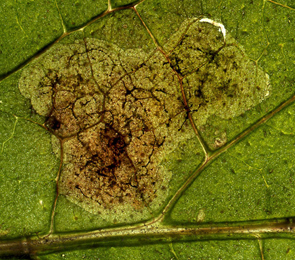|
||||||
|
Phytomyza
medicaginis Hering, 1925 Phytomyza
medicaginis Hering, 1925. Z. Morph. Okol. Tiere 4:
510. |
|||||||||||||||||||||||||||||||||||||||||||||||||||||||||||||||||||||||||||||||||||||||||||||||
Leaf-miner: Mine initially linear, later developing into a whitish blotch, becoming blackish. Pupation in mine on lower surface. The mine begins as an upper surface blotch in the centre of the leaf, from where corridors radiate, each with one larva. After a while these rays fuse, resulting in one large, brown, blotch. Frass in irregular strings. Pupation in principle outside the mine, exit slit in lower epidermis (always?). Often the puparium protrudes from the opening (Bladmineerders van Europa).
Larva: The larvae of flies are leg-less maggots without a head capsule (see examples). They never have thoracic or abdominal legs. They do not have chewing mouthparts, although they do have a characteristic cephalo-pharyngeal skeleton (see examples), usually visible internally through the body wall. The larva is illustrated in Bladmineerders van Europa. Puparium: The puparia of flies are formed within the hardened last larval skin or puparium and as a result sheaths enclosing head appendages, wings and legs are not visible externally (see examples). Normally dark reddish-brown. The puparium is illustrated in Bladmineerders van Europa. Comments: Martinez (2004 in Fauna Europaea) included symphyti Hendel (1935) as a junior synonym of medicaginis Hering (1925). Hosts in Great Britain and Ireland:
Hosts elsewhere:
Time of year - mines: August, October. Time of year - adults: September-October. Distribution in Great Britain and Ireland: Local but widespread. Oxfordshire (Oxford), Devon (Slapton), Huntingdonshire (Woodwalton Fen), Derbyshire (Miller's Dale) (Spencer, 1972b: 90), Haddington (Longniddry) (Bland, 1994c: 84) and Warwickshire (Bedford) (Robbins, 1991: 96). Distribution elsewhere: Widespread in continental Europe (Spencer, 1990: 198) including Belgium, Czech Republic, French mainland, Germany, Lithuania and Poland (Fauna Europaea). NBN Atlas links to known host species:
British and Irish Parasitoids in Britain and elsewhere:
|
|
|
|
| External links: | Search the internet: |
| Biodiversity Heritage Library Bladmineerders van Europa British leafminers Encyclopedia of Life Fauna Europaea NBN Atlas NHM UK Checklist |
Find
using Google Find using Google Scholar Find images using Google |
| Last updated 06-Dec-2017 Brian Pitkin | ||

